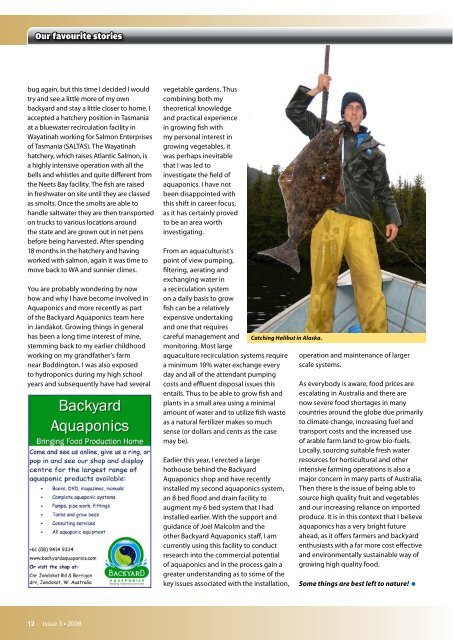Keeping Trout - Backyard Magazines
Keeping Trout - Backyard Magazines
Keeping Trout - Backyard Magazines
Create successful ePaper yourself
Turn your PDF publications into a flip-book with our unique Google optimized e-Paper software.
Our favourite stories<br />
bug again, but this time I decided I would<br />
try and see a little more of my own<br />
backyard and stay a little closer to home. I<br />
accepted a hatchery position in Tasmania<br />
at a bluewater recirculation facility in<br />
Wayatinah working for Salmon Enterprises<br />
of Tasmania (SALTAS). The Wayatinah<br />
hatchery, which raises Atlantic Salmon, is<br />
a highly intensive operation with all the<br />
bells and whistles and quite different from<br />
the Neets Bay facility. The fish are raised<br />
in freshwater on site until they are classed<br />
as smolts. Once the smolts are able to<br />
handle saltwater they are then transported<br />
on trucks to various locations around<br />
the state and are grown out in net pens<br />
before being harvested. After spending<br />
18 months in the hatchery and having<br />
worked with salmon, again it was time to<br />
move back to WA and sunnier climes.<br />
You are probably wondering by now<br />
how and why I have become involved in<br />
Aquaponics and more recently as part<br />
of the <strong>Backyard</strong> Aquaponics team here<br />
in Jandakot. Growing things in general<br />
has been a long time interest of mine,<br />
stemming back to my earlier childhood<br />
working on my grandfather’s farm<br />
near Boddington. I was also exposed<br />
to hydroponics during my high school<br />
years and subsequently have had several<br />
12 Issue 3 • 2008<br />
vegetable gardens. Thus<br />
combining both my<br />
theoretical knowledge<br />
and practical experience<br />
in growing fish with<br />
my personal interest in<br />
growing vegetables, it<br />
was perhaps inevitable<br />
that I was led to<br />
investigate the field of<br />
aquaponics. I have not<br />
been disappointed with<br />
this shift in career focus,<br />
as it has certainly proved<br />
to be an area worth<br />
investigating.<br />
From an aquaculturist’s<br />
point of view pumping,<br />
filtering, aerating and<br />
exchanging water in<br />
a recirculation system<br />
on a daily basis to grow<br />
fish can be a relatively<br />
expensive undertaking<br />
and one that requires<br />
careful management and<br />
monitoring. Most large<br />
aquaculture recirculation systems require<br />
a minimum 10% water exchange every<br />
day and all of the attendant pumping<br />
costs and effluent disposal issues this<br />
entails. Thus to be able to grow fish and<br />
plants in a small area using a minimal<br />
amount of water and to utilize fish waste<br />
as a natural fertilizer makes so much<br />
sense (or dollars and cents as the case<br />
may be).<br />
Catching Halibut in Alaska.<br />
Earlier this year, I erected a large<br />
hothouse behind the <strong>Backyard</strong><br />
Aquaponics shop and have recently<br />
installed my second aquaponics system,<br />
an 8 bed flood and drain facility to<br />
augment my 6 bed system that I had<br />
installed earlier. With the support and<br />
guidance of Joel Malcolm and the<br />
other <strong>Backyard</strong> Aquaponics staff, I am<br />
currently using this facility to conduct<br />
research into the commercial potential<br />
of aquaponics and in the process gain a<br />
greater understanding as to some of the<br />
key issues associated with the installation,<br />
operation and maintenance of larger<br />
scale systems.<br />
As everybody is aware, food prices are<br />
escalating in Australia and there are<br />
now severe food shortages in many<br />
countries around the globe due primarily<br />
to climate change, increasing fuel and<br />
transport costs and the increased use<br />
of arable farm land to grow bio-fuels.<br />
Locally, sourcing suitable fresh water<br />
resources for horticultural and other<br />
intensive farming operations is also a<br />
major concern in many parts of Australia.<br />
Then there is the issue of being able to<br />
source high quality fruit and vegetables<br />
and our increasing reliance on imported<br />
produce. It is in this context that I believe<br />
aquaponics has a very bright future<br />
ahead, as it offers farmers and backyard<br />
enthusiasts with a far more cost effective<br />
and environmentally sustainable way of<br />
growing high quality food.<br />
Some things are best left to nature!


